The average American uses about 90 gallons of water each day in the home. The average American family uses more than 300 gallons of water per day at home.
Water Saving Techniques
With an exponentially growing population and ever booming development, California is projected to face multiple water crises in the future. Droughts will only make this worse, and they will only get more frequent and severe as climate change worsens. These are some simple tricks you can implement into your daily life to help ease the burden on your municipal water supply while saving some money on your water bill in the process.
- Turn off the faucet while shaving and brushing your teeth
- Turning off the tap while shaving can save 10 gallons of water per shave and while brushing your teeth, can save 8 gallons of water per day.
- Assuming you brush your teeth twice daily and shave 5 times per week, you could save nearly 5,700 gallons per year.
- Only run the washing machine and dishwasher when you have a full load.
- Running the dishwasher only when it’s full can eliminate one load of dishes per week and save the average family nearly 320 gallons of water annually.
- Using the appropriate water level or load size selection on the washing machine can also do the trick.
- Turn off the faucet when you are applying detergent while washing dishes.
- Letting your faucet run for five minutes while washing dishes can waste 10 gallons of water and uses enough energy to power a 60-watt light bulb for 18 hours.
- Plug up the sink or use a wash basin if washing dishes by hand.
- Scrape your plate instead of rinsing it before loading it into the dishwasher.
- Keep a pitcher of drinking water in the refrigerator instead of letting the faucet run until the water is cool.
- Thaw in the refrigerator overnight rather than using a running tap of hot water.
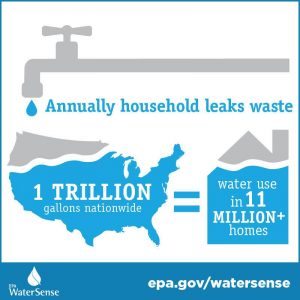
- Fix leaks.
- The average family can waste 180 gallons per week, or 9,400 gallons of water annually, from household leaks. That’s equivalent to the amount of water needed to wash more than 300 loads of laundry.
- Household leaks can waste approximately nearly 900 billion gallons of water annually nationwide. That’s equal to the annual household water use of nearly 11 million homes.
- Sweep driveways, sidewalks, and steps rather than hosing off.
- Wash the car with water from a bucket, or consider using a commercial car wash that recycles water.
- If you have a pool, use a cover to reduce evaporation when the pool is not being used.
- Install a dual flush or low flow toilet or put a conversion kit on your existing toilet.
- Use a low flow shower head and faucet aerators.
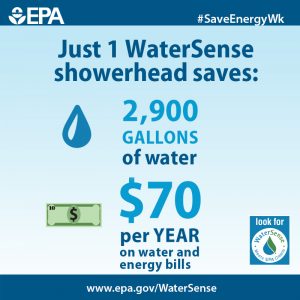
- Don’t overwater your lawn or water during peak periods, and install rain sensors on irrigation systems.
- Install a rain barrel for outdoor watering.
- Plant a rain garden for catching stormwater runoff from your roof, driveway, and other hard surfaces.
- Use regionally appropriate, drought-tolerant, or native plants that thrive in your climate.
- Add mulch to plant beds.
- Mulch helps to reduce evaporation, inhibit weed growth, moderate soil temperature, and prevent erosion. Types of mulches include bark chips, grass clippings, straw, leaves, stones, and brick chips.
- Check sprinkler heads for breaks or leaks and make sure water is going where it’s needed. Fix sprinkler heads that are broken or spraying on the sidewalk, street, or driveway.
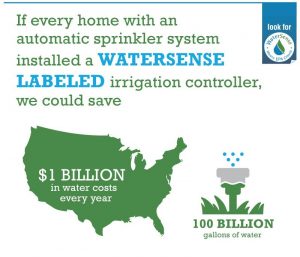
- Test your irrigation system to ensure the zones are programmed correctly.
- Check your irrigation system to look for water efficiency improvements.
- Create an irrigation schedule that makes seasonal adjustments easy.
- Retrofit your irrigation system with new, water-efficient technologies, such as a WaterSense labeled controller, rainfall sensor, or high-efficiency sprinkler nozzles.
- Employ a professional WaterSense certified contractor to audit, install, or maintain home irrigation systems to ensure water isn’t wasted. Be sure to ask for credentials.
- Monitor your water usage on your water bill and ask your local government about a home water audit.
- Use drip irrigation and other water efficient methods to water your lawn
- As much as 50 percent of the water we use outdoors is lost due to wind, evaporation, and runoff caused by inefficient irrigation methods and systems. A household with an automatic landscape irrigation system that isn’t properly maintained and operated can waste up to 25,000 gallons of water annually.
- Irrigate your lawn in the morning or late at night to minimize losses to evaporation.
- Watering after the sun goes down can prevent significant losses of water from evaporation during the heat of the day
- WaterSense labels products that are 20 percent more water-efficient and perform as well as or better than standard models.
- The average family can save 13,000 gallons of water and $130 in water costs per year by replacing all old, inefficient toilets in their home with WaterSense labeled models.
- Replacing old, inefficient bathroom faucets and aerators with WaterSense labeled models can save the average family $250 in water and electricity costs over the faucets’ lifetime.
- Replacing showerheads with WaterSense labeled models can reduce the average family’s water and electricity costs by $70 and can save the average family more than 2,700 gallons of water per year, equal to the amount of water needed to wash 88 loads of laundry.
- Giving a home’s main bathroom a high-efficiency makeover by installing a WaterSense labeled toilet, showerhead, and faucet aerator can pay for itself in as little as 1 year.
- Replacing a standard clock timer with a WaterSense labeled irrigation controller can reduce an average home’s irrigation water use by 15 percent and can save an average home nearly 7,600 gallons of water annually.
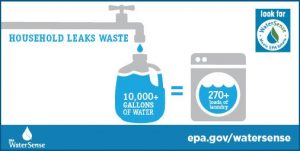
Fixing leaks, as mentioned above, can help you save an enormous amount of water. Here are some ways the EPA recommends you check for leaks:
- Take a look at your water usage during a colder month, such as January or February. If a family of four exceeds 12,000 gallons per month, there are serious leaks.
- Check your water meter before and after a two-hour period when no water is being used. If the meter changes at all, you probably have a leak.
- Identify toilet leaks by placing a drop of food coloring in the toilet tank. If any color shows up in the bowl after 10 minutes, you have a leak. (Be sure to flush immediately after the experiment to avoid staining the tank.)
- Examine faucet gaskets and pipe fittings for any water on the outside of the pipe to check for surface leaks.
Copyright © 2019 - 2024 CAWaterConservancy.org.
